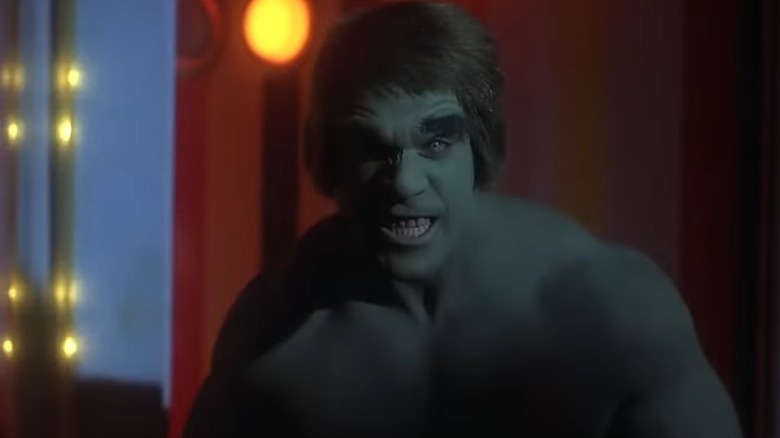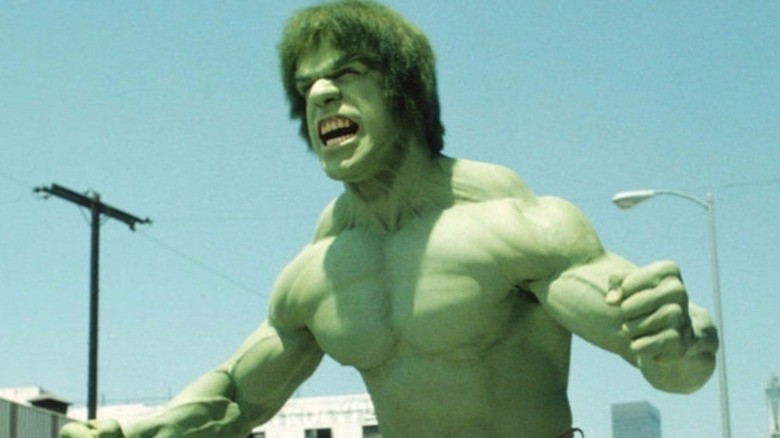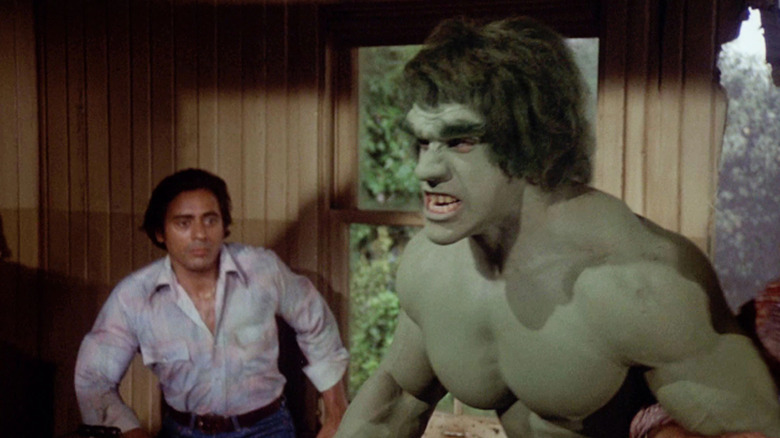A Kid's Complaint Got Lou Ferrigno Hired (And Richard Kiel Fired) As The Incredible Hulk
The Incredible Hulk, created by Jack Kirby and Stan Lee in 1962, is a character born more from universal monster movies and 1950s sci-fi than more modern notions of complex, interlaced comic book lore. In the original comic books, a spindly physicist named Bruce Banner was exposed to a strange type of radiation while saving a soldier from a nuclear bomb test. Rather than killing him, the radiation mutated his body into that of a bulky, over-muscled brute. He eventually shrunk back to his normal size, but Bruce eventually found that whenever he got angry, he would transform back into an unstoppable radioactive ogre. Indeed, he was so angry, he couldn't speak or think clearly.
The Hulk became one of the more popular characters in a new wave of Marvel Comics that debuted in the 1960s (Spider-Man, the X-Men, Iron Man, the Fantastic Four, and Thor all came from this wave). He was popular enough to be included in the Avengers, a mash-up superhero team comic book that arbitrarily threw some of Marvel's most popular characters together to combine their respective fans. To this day, those characters are frequently united in cinematic form.
Upon only brief reflection, the Hulk reveals himself to be a tragic figure. If Bruce cannot control his emotions, he has the capacity for destruction and death. Practically speaking, the Hulk could not be a superhero, but a reluctant monster like the Wolf Man. In 1978, that tragedy became the central theme of the popular TV series "The Incredible Hulk" starring Bruce Bixby as David Banner (they changed his name for the show) and bodybuilder Lou Ferrigno as the Hulk.
Looking the part
David Banner, cursed by his monsterism, lived on the road as a vagabond. He was alone. The show's closing theme song — a piano tune by Joe Harnell called "The Lonely Man" — wasn't about his ability to transform or commit acts of comic mayhem, but his isolation. Whenever David stopped in a small town on his travels, he would inevitably use his Hulk powers to help someone in need. Revealed, he could no longer settle down and took the road once more.
Why was the Hulk green? It seems that, in the 1960s, green was a much more exciting color to see on the comic book page than the Hulk's original grey. The Hulk's verdure became strongly associated with the character, and it was important to the makers of the "Hulk" TV series that he retain his recognizable shade. Less important to the showrunners was the Hulk's muscular physique. Given that he was a monster, someone in production felt that any outsize actor could play the role, and they initially hired Richard Kiel to play the Hulk. Kiel was the 7'2" star of films like "Moonraker," "Cannonball Run II," and "Happy Gilmore."
In a 2022 interview with the Guardian, Ferrigno tells a story that a little kid (and "Incredible Hulk" reader) supposedly visited the "Hulk" set early in its production and reacted negatively to Kiel. While the "Eegah" actor would have likely made a fine Hulk, he didn't look the part. These days, one can create an over-muscled giant via CGI, and a normal-sized actor like Mark Ruffalo can play the Hulk in motion capture. In 1978, they needed a muscled human being. Luckily, a documentary called "Pumping Iron" had been released the year before, and Lou Ferrigno was now a recognizable face.
'I knew how Hulk felt'
As Lou Ferrigno recalled:
"I got a part in 'Pumping Iron' with Arnold Schwarzenegger but I'd never acted before. I moved to California and was training for the 1977 Mr. Olympia bodybuilding contest when I got an audition for 'The Incredible Hulk.' They'd started filming the pilot episode with Richard Kiel, who played Jaws in the James Bond movies, but a kid on the set said he wasn't right and he needed to have big muscles like in the comics. I went for the screen test, got painted green, and was asked to show emotion. That came naturally — I knew how Hulk felt — and I got hired."
Between playing the Hulk and facing off against Schwarzenegger in "Pumping Iron," Ferrigno became a major celebrity very quickly. He was already a rising figure in the world of bodybuilding, but after "The Incredible Hulk," he was also a major entertainment star. To this day, one can attend any number of comic book and pop culture conventions and get Ferrigno, now 71, to sign a Hulk photograph.
Ferrigno's association with the character even landed him a cameo role — as a security guard — in Louis Leterrier's 2008 feature film "The Incredible Hulk," which was eventually backward-engineered to be part of the Marvel Cinematic Universe. Ferrigno also played the voice of that film's CGI rendition of the Hulk. He may take a great deal of pride in the fact that the radioactive monster now requires extensive special effects to visualize when he was doing it with his own body some 40 years prior.


